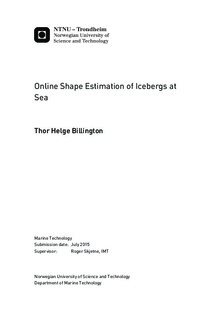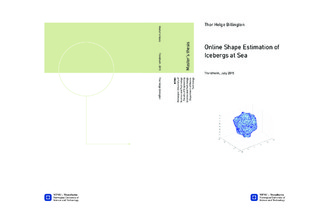| dc.description.abstract | Offshore operations in the Arctic present several challenges, such as the threat of icebergs colliding with offshore structures.This thesis will investigate methods of estimating the shape and size of iceberg keel geometries. Accurate information of iceberg size and geometry is important for forecasting future iceberg trajectories, and for calculating local and global loads generated by an iceberg s impact on offshore structures. The iceberg shape and size is also useful for determining its stability before a towing operation to avoid rope slippage or the iceberg rolling over.
We have proposed a method on how iceberg surface data can be used in a towing operation for predicting its stability. This has been done by using surface lengths on icebergs to estimate their draft with a 95 \% confidence interval based on previous surface length and keel draft data. The estimated draft has been used to scale trapezoidal shapes to represent iceberg keels, and then used to calculate the iceberg s GZ curve. We discovered that the trapezoidal shapes gave poor shape estimations for stability calculations. This was because the volume distribution of a true iceberg was represented poorly, especially close to the water surface.
We utilized an artificial neural network (ANN) in order to estimate the shape of an iceberg keel based on iceberg surface date. The (ANN) was made by 2D iceberg keel geometries from surface data, because 3d iceberg data is scarce. The original 2D iceberg continuous profile was reduced into 8 vertices for both sail and keel geometry. This created an input matrix representing the sail geometry, and a target matrix representing the keel geometry used to train the ANN with 42 2D iceberg samples. The ANN gave more accurate results than for the trapezoidal method.
We have also presented a case study on rebuilding reduced keel geometry data using shape factors with an ANN . The objection of the case study was to reduce iceberg data gathered by an AUV so that it can be transmitted real time to a surface vessel for processing. It was difficult to evaluate the performance of the ANN due to the low sample size, and because the shape factors used for estimation, were also used to measure the performance. | |

